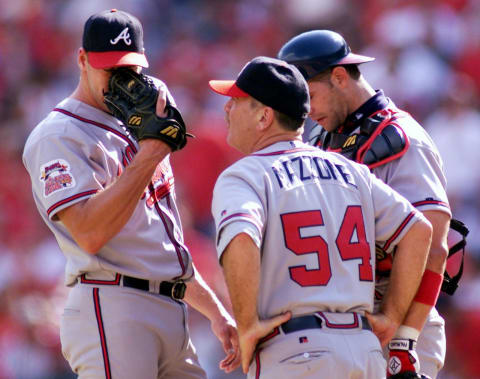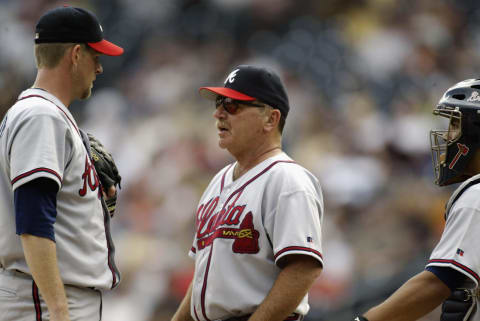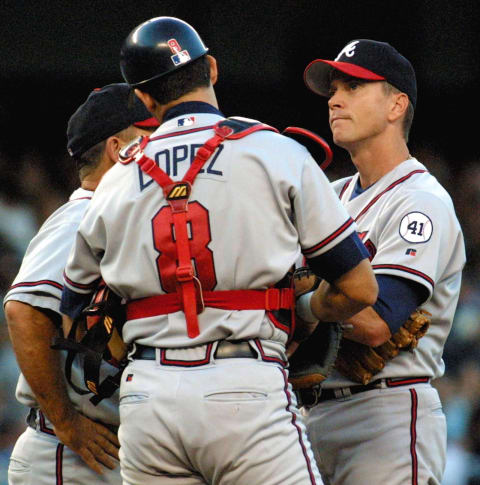Atlanta Braves “Learning From Leo” Series Taps into Mazzone’s Mentality


New three-part interview series dives deep into the Atlanta Braves pitching success under Leo Mazzone.
Inside the mind of legendary Atlanta Braves pitching coach Leo Mazzone lies a treasure trove of baseball knowledge that surprisingly few have tapped into since his retirement.
To Mazzone, especially during the Braves unprecedented run of 14 consecutive division titles, pitching was an art form often dictated by the canvas of skills a player already possessed.
Those who were fortunate enough to drill into the intricacies of baseball’s proverbial savant of pitching success regularly uncovered gems that went far beyond the philosophy of most.
But now it’s our turn to soak up his expertise.
Enter part one of the three-part episodic series, “Learning From Leo,” which was released today on youtube by FlatGround. Led by Founder and CEO Rob Freidman (renowned for his @PitchingNinja Twitter account) and college baseball and FlatGround Content Provider Josh Rudd, the FlatGround platform supplies clips of amateur and semi-pro pitchers to its sizable social audience.
With “Learning From Leo,” Friedman and Rudd, along with Furman University Pitching Coach and Mazzone mentee Kaleb Davis, pick the brain of the Atlanta Braves architect who served as the team’s pitching professor from 1990-2005. Mazzone, now a Special Advisor with Furman baseball, has helped shape Davis’ outlook on pitching development and the program’s vision for placing health and durability as the top priority for their staff.
But it really doesn’t matter if you’re an Atlanta Braves aficionado, a pitching guru, or a young hurler seeking sound advice.
There’s a significant supply of pitching wisdom from one of the greatest minds in baseball history to unlock here.
The incredible insight ventures back decades to Mazzone’s then-budding relationship with former Braves player and coach Johnny Sain over “cornbread, beans, and sipping vodka.” It was there that he formed the recipe and philosophy for getting hitters out: As Mazzone bluntly puts it, “Stuff, movement, change of speeds, location, and motion.”

Inside Leo Mazzone
Among other things, Mazzone shares his thoughts on whether Sid Bream was safe at the plate during the 1992 National League Championship Series, the downsides of flat-footed throwing sessions for pitchers in between starts, the power of Javy Lopez’ presentation skills to both the pitcher and umpire, and, hysterical vignettes, like the time Greg Maddux requested Mazzone make a mound visit during one of his starts because the Hall-of-Famer was “lonely.”
In the late 1980s, when Bobby Cox began restructuring the Braves into an organization built on pitching, he was mesmerized by Mazzone’s minor league track record for cultivating pitchers who didn’t breakdown or suffer significant injuries.
When Mazzone took the job as pitching coach in Atlanta in 1990, he said Cox told him “I don’t care what you do, you take care of those pitchers. You be with them, get to know them, learn them and know everything about them. I want you to remember one thing, just because a pitcher is in the big leagues, don’t take for granted that he knows everything he’s doing.”
As baseball transitioned from a four-man rotation into a five-man configuration, Mazzone quickly recognized the benefits of having a pitcher throw, with controlled effort, on the scheduled additional day of rest.
So, the mindset was to throw more often with less exertion.
While many pitching coaches envisioned the additional day would provide a much-needed reprieve for their staff and as others chose to throw flat-footed in the outfield between starts, Mazzone was ultimately regulating his hurler’s efforts to keep them sharp on four-days’ rest, while healthy for a five-day setup.
The regimen was simple: start, take a day off, throw two side sessions, take a day off, and pitch.

Leo Mazzone as Communicator
At times during the premiere episode, a rightfully amped up Mazzone stressed the importance of trust between coach and pitcher, the stigma of leaning on velocity, and controlling effort while avoiding falling “into the trap of putting a stamp or fingerprint on a pitcher.”
Reshaping and revving past Atlanta Braves like John Burkett, Russ Ortiz, Jaret Wright and Marvin Freeman started by dissecting bullpen sessions, concentrating on control effort over velocity, and simply listening.
“I got a degree in psychology and I never went to college,” Mazzone said during the interview. “Your approach to the pitcher is based on their mentality and makeup, and that determines your presentation to the pitcher.”
One Mazzone story, in particular, stands out following the infamous John Smoltz for Doyle Alexander trade with the Detroit Tigers. At the time, Smoltz was a well-regarded power pitcher with control issues. Soon after the transaction, he met Mazzone in an Instructional League backfield for a throwing session.
While running through the motions, Mazzone urged Smoltz to forget about directives from past coaches and simply wind up and follow his comfort zone. From that point, Smoltz was suddenly hitting his targets. Coupled with “a throw, turn and pull breaking ball” in famous Sain fashion, Smoltz was a reinvented man.
Mazzone admitted, “It was one of the most beautiful deliveries I’ve ever seen.” Cox, wanting little fanfare for an Instructional League trip, flew down to witness the reformed Smoltz, and, as if on cue, the future Hall of Famer went five innings, striking out eight and walking one.
“I let (Smoltz) be himself,” Mazzone said.
Pros and Cons of Pursuing Lindor. dark. Next
Episodes two and three of “Learning From Leo” air May 20 and May 27 on Rudd’s YouTube channel. Prior to release, check back with Tomahawk Take for previews of each episode.